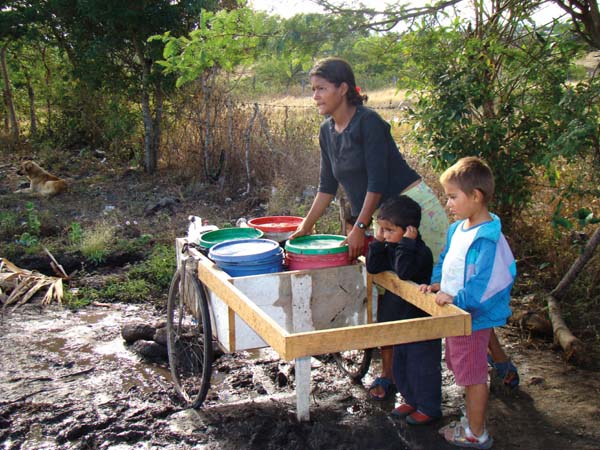
Nicaragua is the largest country in Central America with an area of 129 494 km2. It has two coasts on the Pacific Ocean to the west and the Caribbean Sea to the east. Its climate is tropical in the coastal plains and cooler in the mountainous northern areas. The Pacific coast is bordered by a chain of volcanoes, some of which are active. Nicaragua has two important freshwater reserves, Lake Cocibolca and Lake Xolotlan. The country is located in an active tectonic zone which makes it vulnerable to earthquakes and the Caribbean coast is exposed to hurricanes.
Nicaragua's population has surpassed the 6 000 000 threshold and, due to the country's geographical profile, a significant proportion of the population is concentrated in the country's Pacific zone. 60% of the population lives in urban areas. More than half of the population is made up of young people under the age of 24.
Nicaragua was colonised by Spain in 1524 and gained independence in 1821. After being part of the United Provinces of Central America, it became a sovereign republic in 1854. Its early history was marked by military interventions by the United States, particularly because of the possibility of digging a canal between the two oceans. The country was also troubled by long periods of military dictatorship, the last of which, dominated by the Somoza family, ended in July 1979 with the emblematic victory of the revolution led by the Frente Sandinista de Liberación Nacional.
After 1979, the country led by the Frente Sandinista de Liberación Nacional and its leader Daniel Ortega lived through a difficult period with a US embargo and the internal war with the US-funded "la Contra". The 1990 elections saw the victory of Violeta Chamorro and paved the way for the gradual stabilisation of the country with free elections and political alternation. After 15 years in opposition, the Frente Sandinista de Liberación Nacional returned to power in 2006. The next presidential elections will be held in November 2021.
Nicaragua is one of the poorest countries in Central America with a GDP of USD 2,029/capita in 2018. Agriculture, livestock, forestry and fishing account for 18% of GDP and trade for 11%, followed by manufacturing (15%). Beef, coffee, gold, sugar and groundnuts account for 60% of total exports. Tourism is also an important source of foreign exchange and accounts for 17% of exports. About 10 % of GDP is contributed by emigrants sending money back to their families.
Public spending in the education sector accounted for 4.5% of GDP in 2020 and in the health sector for 5.6%.
Furthermore, Nicaragua's economy is heavily reliant on the informal sector, which employs 75% of the workforce, many of whom have not had the opportunity to complete the compulsory six years of primary education.
This is one of the reasons why cooperation efforts between Luxembourg and Nicaragua are focused on the vocational training and integration sector and on the promising tourism sector. This makes it possible both to develop training with the assurance that it meets the needs of workers and companies and to strengthen economic activities linked to tourism, which can be considered a tool for local development, both in urban and rural areas.
Poverty has a high incidence in Nicaragua (in 2020 more than 55% of the population lived below the poverty line) and inequalities remain very high (in 2020, the richest 20% of the population occupied 65% of the country's income, while the poorest 20% occupied only 3%).
Nicaragua has been a partner country of Luxembourg Cooperation since the 1990s and a General Cooperation Agreement was signed in 2000. The first Indicative Cooperation Programme (ICP) was drawn up in 2003, which progressively enabled interventions to be better structured. As soon as the second ICP was signed in 2007, the sectors of training and professional integration, tourism and health were identified as focal sectors. The year 2014 was marked by the identification of new programmes and the negotiation of an amendment which provides for the extension of the ICP III over a period of three years in order to ensure the transition to a joint programming modality with the European Union from 2018.
From 2019, and following the socio-political crisis in the country, Luxembourg Cooperation decided to freeze bilateral cooperation with Nicaragua. The identification of new programmes for the period 2023 - 2027 favours a regional approach to interventions in Central America.
As of 2020, LuxDev's Regional Technical Assistance Fund (RTF) aims to strengthen the capacities of existing Luxembourg Cooperation partners in the region. The RTAF focuses on the cross-cutting priorities of the 2030 strategy of Luxembourg Cooperation, including human rights, gender equality, environmental sustainability, as well as on the theme of innovative technologies and capacity building.
In line with this regional strategy, LuxDev will finance, as of 2021, a regional programme to strengthen women's entrepreneurship in the eight countries of the Central American Integration System (SICA), for which the Centre for the Promotion of Micro, Small and Medium-sized Enterprises (CENPROMYPE) is responsible.
The Luxembourg Cooperation's interest in environmental resilience and climate change has made it possible to finance a regional programme for the management of secondary forests in Central America. Indeed, while the intensity and problems related to deforestation and forest degradation are well known, very little has been done to establish systems for the management and sustainable use of secondary forests.
